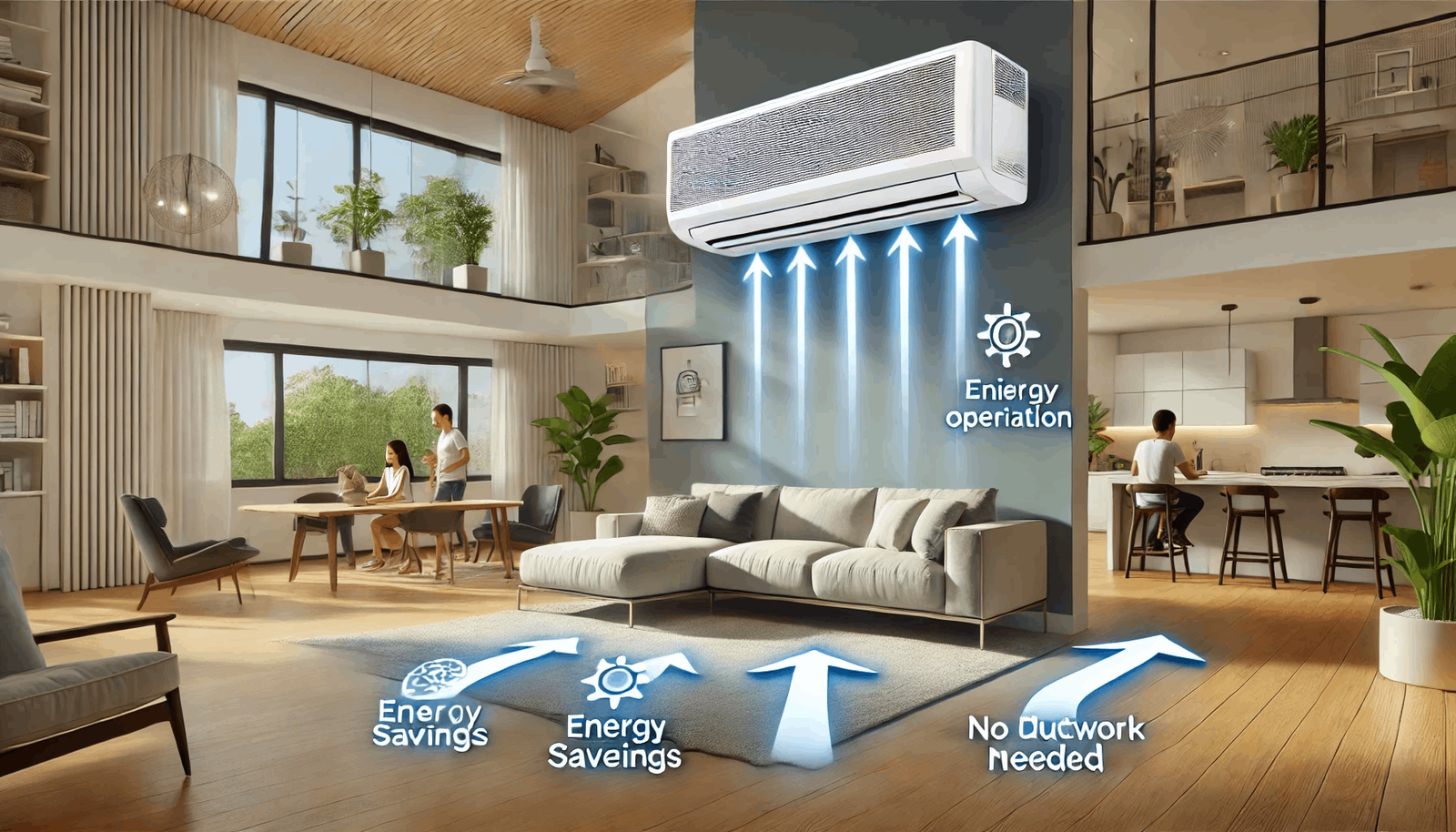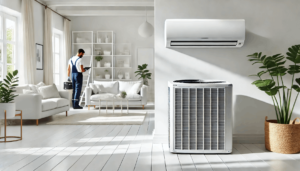Introduction
As homeowners continue to seek more energy-efficient and cost-effective cooling solutions, the ductless air conditioner has emerged as an innovative option. Unlike traditional HVAC systems, which rely on ductwork to distribute air throughout your home, ductless air conditioners provide targeted cooling directly to specific areas or rooms. This offers numerous benefits such as enhanced energy efficiency, personalized comfort, and easier installation. Whether you’re upgrading an outdated system or adding cooling to a new space, understanding the benefits of a ductless air conditioner can help you make the best choice for your home.
Ductless air conditioners are gaining popularity in Ontario and across North America, particularly in homes that lack existing ductwork or where homeowners seek zone-based cooling options. In this blog, we will explore why you should consider a ductless system, how it works, and the key advantages that could make it the perfect solution for your home’s cooling needs.
What Is a Ductless Air Conditioner?
A ductless air conditioner, also known as a mini-split system, is a type of HVAC system designed to cool individual rooms or zones without the need for ductwork. This system is popular for its energy efficiency, flexibility, and ability to provide targeted cooling in spaces that might not be compatible with traditional air conditioning systems. Ductless air conditioners are widely used in homes, offices, and other buildings where installing extensive ductwork would be costly or impractical.
How Does a Ductless Air Conditioner Work?
A ductless air conditioner works by using two main components: an indoor unit and an outdoor compressor. The outdoor unit is typically installed outside the building, while the indoor unit is mounted on a wall or ceiling in the room or zone you want to cool. The two units are connected by a conduit that houses the power cable, refrigerant tubing, and a condensate drain.
The cooling process begins when the indoor unit pulls warm air from the room and passes it over cold evaporator coils. This air is cooled by the refrigerant, which absorbs the heat. The warm air is then transferred to the outdoor unit through the conduit, where the heat is released outside. The cooled air is then blown back into the room, maintaining the desired temperature.
One of the key features of a ductless air conditioner is its ability to provide zoned cooling, which allows homeowners to cool specific areas of their home without wasting energy on unoccupied rooms.
Key Components of a Ductless Air Conditioning System

The primary components of a ductless air conditioning system include:
- Indoor Unit: This is the visible part of the system, usually mounted high on a wall or ceiling. It contains the evaporator coils and a fan that circulates the cooled air.
- Outdoor Unit (Compressor/Condenser): This part is placed outside the home and works to release the heat absorbed from inside the building. It contains the compressor, which is crucial for circulating the refrigerant.
- Conduit: The indoor and outdoor units are connected by a conduit that contains the refrigerant line, power cable, and drainage pipe. This connection enables the heat transfer between the two units.
- Remote Control or Thermostat: Most ductless systems come with a remote control or thermostat for adjusting the temperature and fan settings, allowing for easy control over the indoor climate.
Ductless vs. Traditional HVAC Systems
The primary difference between ductless air conditioners and traditional HVAC systems is the absence of ductwork. Traditional HVAC systems rely on ducts to distribute cooled or heated air throughout the home, which can lead to energy losses if the ducts are not properly sealed or insulated. On the other hand, ductless systems deliver air directly to the room, avoiding the energy waste commonly associated with ducts.
Another advantage of ductless systems is their flexibility. With a traditional system, you must cool the entire home even if you only need cooling in one or two rooms. Ductless air conditioners allow you to set different temperatures in different zones, improving comfort and efficiency. Additionally, the installation of a ductless system is less invasive and quicker compared to the extensive ductwork required by central air systems.
Top Benefits of a Ductless Air Conditioner
Ductless air conditioners, also known as mini-split systems, have become increasingly popular due to their flexibility, efficiency, and ease of installation. These systems offer numerous advantages over traditional HVAC systems, making them a great choice for homeowners seeking to enhance comfort while reducing energy costs.
Energy Efficiency and Lower Utility Bills

One of the most significant benefits of a ductless air conditioner is its energy efficiency. Traditional HVAC systems often lose up to 30% of their energy through ductwork. In contrast, ductless systems deliver cooled air directly into the room, eliminating the energy losses associated with ducts.
Additionally, ductless systems use inverter technology to adjust the compressor speed based on the cooling demand. Instead of cycling on and off like traditional systems, a ductless air conditioner can run continuously at a lower power level, maintaining a consistent temperature and reducing energy consumption. This leads to lower utility bills, especially during peak summer months when air conditioning is used heavily.
Zoned Cooling for Personalized Comfort
Ductless air conditioners offer the option for zoned cooling, allowing homeowners to cool specific areas of their home while leaving other rooms untouched. This feature is particularly useful for homes with multiple rooms that have varying cooling needs.
With zoned cooling, you can control the temperature in each zone independently, providing personalized comfort in different areas. For example, you can cool your living room while turning off the system in bedrooms or other unused spaces, reducing energy consumption and saving on costs. Moreover, each family member can set their preferred temperature in different rooms, enhancing overall comfort.
Improved Indoor Air Quality
Indoor air quality is an essential factor in maintaining a healthy living environment, and ductless air conditioners are designed to improve it. Traditional HVAC systems can collect dust, allergens, and other pollutants in their ducts, which can be recirculated into the air when the system is running. Since ductless systems do not rely on ducts, there is no risk of pollutants building up and contaminating the air.
Additionally, many ductless systems come equipped with advanced filtration systems that help remove allergens, dust, and other harmful particles from the air, resulting in cleaner and healthier indoor air. This feature is especially beneficial for individuals with allergies, asthma, or other respiratory issues, making ductless systems a healthier choice for your home.
Easy Installation and Minimal Disruption
One of the key advantages of a ductless air conditioner is its easy installation process. Unlike traditional HVAC systems, which require extensive ductwork and modifications to your home, ductless systems can be installed with minimal disruption. A professional HVAC technician can typically install a ductless system in just one day.
The indoor unit is mounted on a wall or ceiling, and the outdoor unit is placed outside the home. These two components are connected by a conduit that requires only a small hole in the wall, making installation less invasive. This simplicity allows homeowners to enjoy cooling comfort without the hassle of major construction or remodeling.
Ideal Situations for Choosing a Ductless Air Conditioner

Ductless air conditioners offer a flexible and efficient cooling solution for a variety of home scenarios. They are particularly beneficial in settings where traditional central air conditioning may not be feasible or cost-effective. Let’s explore some ideal situations where opting for a ductless air conditioner is the best choice.
Perfect for Older Homes Without Ductwork
Many older homes, especially those built before the widespread adoption of central air systems, were not designed with ductwork in place. Retrofitting these homes with traditional ducted HVAC systems can be a daunting and expensive task, often involving extensive renovations that disrupt the integrity and aesthetic of the property.
In such cases, a ductless air conditioner is an excellent alternative. Since ductless systems do not rely on ducts, they can be installed in virtually any space without the need for invasive construction. This makes them a particularly appealing choice for homeowners who want to maintain the historical character of their property while ensuring modern comfort. The small conduit required for installation minimizes any damage to the structure, offering a hassle-free solution.
Additionally, ductless systems are often more energy-efficient for older homes where insulation may be less effective, helping to keep cooling costs down.
Best Solution for Room Additions or Renovations
When adding a new room or completing a renovation, extending the home’s existing HVAC system may not always be practical. Adding new ductwork can be both costly and disruptive, especially when considering the complexities of integrating it with the rest of the home. In these scenarios, a ductless mini-split system is a perfect choice.
Ductless air conditioners are ideal for room additions, such as garages, sunrooms, or finished basements, where running new ducts would be too complex or expensive. Rather than attempting to push the existing HVAC system beyond its limits, installing a ductless system in the new space allows for targeted cooling without overloading the home’s current system.
Additionally, ductless systems allow homeowners to control the temperature in these new spaces independently from the rest of the house, giving them complete flexibility over their comfort needs.
Ideal for Home Offices and Individual Rooms
In today’s era of remote work, many people are setting up home offices, which may require their own cooling solution. Ductless air conditioners are perfect for this use case because they allow for zoned cooling, which can be tailored to the specific needs of the workspace. This ensures that your home office stays cool throughout the workday without having to run the central air system and cool the entire home.
The ability to control temperatures independently is especially valuable in homes where different family members may be occupying separate rooms at different times of the day. For example, a home office may need cooling during working hours, while bedrooms only need cooling at night. A ductless air conditioner allows you to efficiently cool each room without wasting energy on unoccupied spaces.
Homeowners can also benefit from installing ductless systems in individual rooms that may not get adequate airflow from the central HVAC system, ensuring consistent comfort across the home.
What to Look for When Buying a Ductless Air Conditioner

Choosing the right ductless air conditioner requires careful consideration of several key factors. It’s not just about picking a system that fits within your budget — you’ll want to ensure that the unit you select will effectively cool your space, operate efficiently, and come with strong after-sales support. Here are the most important things to look for when purchasing a ductless air conditioner.
Choosing the Right Capacity for Your Space
One of the first things to consider when buying a ductless air conditioner is the system’s capacity. The cooling capacity of an air conditioner is measured in BTUs (British Thermal Units), which indicates how much heat the system can remove from a room per hour. To achieve optimal comfort, it’s important to match the capacity of the unit to the size of the space you want to cool.
If you choose a unit that’s too small for the room, it will struggle to cool the space efficiently, leading to higher energy bills and reduced comfort. On the other hand, a unit that’s too large for the space will cool the room too quickly, causing the system to cycle on and off frequently. This can increase wear and tear on the unit and result in inconsistent temperature regulation.
As a general rule of thumb, smaller rooms (up to 300 square feet) may require units with capacities of 9,000 BTUs, while larger spaces (up to 1,500 square feet) could need units with capacities of 24,000 BTUs or more. To ensure you’re choosing the right size, it’s often recommended to consult with an HVAC professional.
Understanding SEER Ratings and Energy Efficiency
Another critical factor to consider when selecting a ductless air conditioner is the unit’s SEER rating. The Seasonal Energy Efficiency Ratio (SEER) measures how efficiently an air conditioner operates over an entire cooling season. The higher the SEER rating, the more efficient the system is, and the more money you’ll save on your energy bills.
Most modern ductless systems have SEER ratings ranging from 15 to 25, but some models can go even higher. While systems with higher SEER ratings tend to have a higher upfront cost, they often pay for themselves over time through reduced energy consumption.
In addition to looking at the SEER rating, you may also want to consider units with Energy Star certification, which ensures that the system meets or exceeds energy efficiency guidelines set by the U.S. Environmental Protection Agency (EPA). Ductless air conditioners are generally known for their energy efficiency, but it’s still essential to compare SEER ratings when shopping for the best system.
Checking Warranties and After-Sales Support
Warranties are an important consideration when investing in a ductless air conditioner, as they provide peace of mind and protect your investment. Most manufacturers offer warranties that cover parts and labor for a specified period, typically ranging from 5 to 10 years.
When comparing ductless air conditioners, make sure to review the terms of the warranty carefully. Look for systems that come with comprehensive coverage that includes both the indoor and outdoor components, as well as any compressors or other key parts that may be prone to wear and tear.
In addition to warranties, it’s also essential to consider the availability of after-sales support. Some manufacturers and HVAC service providers offer regular maintenance plans, which can help keep your system running smoothly and extend its lifespan. Others may offer support for troubleshooting and repairs, making it easier to address any issues that arise after installation.
Before making a final decision, ensure that the manufacturer or service provider has a solid reputation for customer service and that you’ll have access to prompt and reliable support if needed.
Conclusion
A ductless air conditioner offers numerous benefits, making it a compelling option for homeowners looking to upgrade or install an efficient, versatile cooling system. Whether you’re focused on energy efficiency, improved indoor air quality, or the convenience of zoned cooling, a ductless system can meet a variety of cooling needs. Additionally, their easy installation and minimal disruption make them ideal for both new constructions and retrofits in older homes without existing ductwork. With their ability to reduce energy costs and provide customized comfort, ductless air conditioners are a great long-term investment for any household.
When choosing a ductless system, consider your space, energy requirements, and the level of after-sales support you’ll receive. Consulting with HVAC professionals can help ensure that the system you select is perfectly tailored to your home.
Resources:
- Energy.gov on Ductless Air Conditioning
- HVAC.com: Guide to Ductless Mini-Split Systems
- Mitsubishi Electric: Benefits of Ductless Systems
- Energy Star: Ductless Heating and Cooling Systems
- HVAC.com: Ductless Mini-Split Systems
- Mitsubishi Comfort: Ductless Air Conditioners
- Energy.gov: Ductless Heating and Cooling Systems
- Mitsubishi Electric: Benefits of Ductless Systems
- Carrier: Mini-Split Systems
- Energy Star: Ductless Heating and Cooling Systems
- Mitsubishi Electric: Ductless Systems for Home Additions
- Daikin: Solutions for Older Homes
- Energy Star: SEER Ratings Explained
- Daikin: Ductless Systems Buying Guide
- Mitsubishi Electric: Ductless System Sizing and Installation
- Energy Star: Benefits of Ductless Heating and Cooling Systems
- Mitsubishi Electric: Benefits of Ductless Systems
- Daikin: Why Choose a Ductless Air Conditioner




